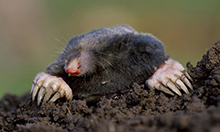Moles
 Common Name:British mammal
Common Name:British mammal
Management and Control: The Mole Talpa europaea is a common British mammal and, although not often seen, the results of its tunnelling are well known to cause damages to gardens areas, molehills and tunnels can be a nuisance. In agricultural fields contamination of grass by soil may lead to poor quality silage being produced. Mole runs may disturb roots and adversely affect plant growth and also can cause damages to lawn mowers and other agricultural machinery used on farms or in the back garden.
Biology and behaviour : Moles are highly territorial and generally live alone in an extensive tunnel system covering an area of 0.1 to 1.6 ha (0.25-4 acres). Mole hills are created as the animals extend and repair their tunnels, which are used as traps to catch their prey, earthworms. A mole can produce a considerable number of hills, particularly where food is in short supply. Three to four young are born in the spring and these disperse, generally over-ground, in mid-summer to try to establish their own territories.
Control : Before embarking on mole control, it is important to consider if this action is warranted or if the molehills and tunnels can be tolerated. Where control measures can be justified, there are two main methods: trapping and gassing with Aluminium Phosphide.
Strychnine (Strychnine Hydrochloride) can no longer be used for mole control in the UK. The approval to purchase and use strychnine for mole control expired on 31 August 2006.
The timing of control is important and is best carried out between October and April. This is when moles are most noticeable as they are actively digging new tunnels. Control at this time also has the benefit of reducing the population prior to the onset of the breeding season.
Trapping and Gassing : The Traps are spring operated and designed to kill the moles. There are two main types of traps are the scissor (or pincer) and the half-barrel trap. These traps can be used by professional and amateur users. Aluminium Phosphide can only be used by professional pest controllers, or personnel who are qualified to use these pesticide or product.
Mole runs : Effective trapping and poisoning relies on locating suitable runs. These are the main tunnels which are usually at least 150 mm or 6 inches below ground. The tunnel can be found by using a suitable probe.




























